Twenty-two years ago, ILM rocked the visual effects world with its photorealistic computer generated dinosaurs in Jurassic Park. That work was hot on the heels of groundbreaking ILM scenes in Terminator 2: Judgment Day, both films paving the way for the future of visual effects and filmmaking. Now, with Colin Trevorrow’s Jurassic World, ILM has returned to dinosaur action, looking once again to up the ante.
fxguide talks to ILM visual effects supervisor Tim Alexander and animation supervisor Glen McIntosh about new approaches this time around, which included motion capture, on-set visualization and advanced flesh sims. We also speak with senior ILM visual effects supervisor Dennis Muren and visual effects consultant Phil Tippett, both pioneers on the original Jurassic Park, and who have returned to lend their considerable weight to Trevorrow’s film.
Return of the giants
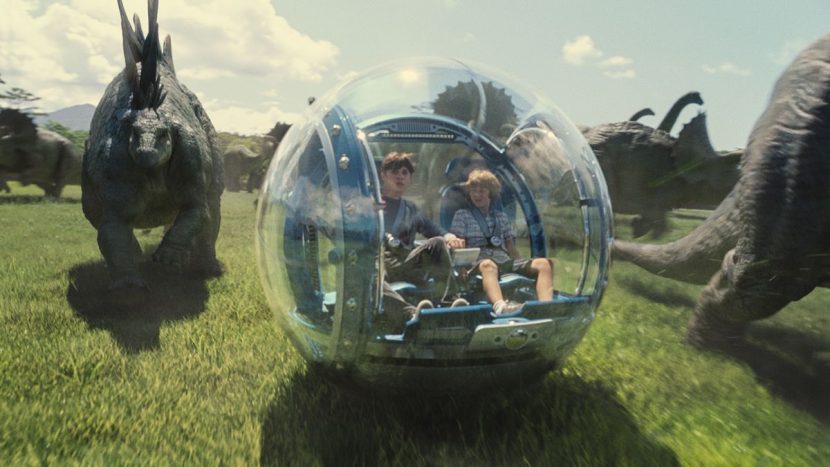
When Muren, who was the visual effects supervisor on both Jurassic Park and its sequel The Lost World, looked back at the work in those two films, he imagined, like he does with all his projects, that the level of visual effects had become ‘obsolete’. “I figure the audience thinks the same way,” he says. “They want to see something different, so you have to figure out what is next? But Jurassic Park has held up.” But, he adds, “Jurassic World has gone beyond those two in the look and emotion of the animals that is really something new.”
And Muren was able to provide key advice to ILM’s current visual effects artists on techniques that he had mastered on Jurassic Park and other films. This included approaches to lighting, such as ensuring there were eye lights on the dinosaurs themselves. “Without a glint in the eye, you don’t know where to look on the head,” comments Muren. “We had the same problem on Dragonslayer. That face was really interesting – but until we put a glint in the eyeball it didn’t look like it was alive. It was actually Phil Tippett’s idea to get little ball bearings and put them in the eyes in Dragonslayer. We tried glass but it didn’t work – a ball bearing was great.”
“The same was true in Jurassic World,” Muren continues. “Once you put those lights in there then you know where to look. We knew people’s faces so well, but animal’s faces are less recognizable and less familiar to being intelligent. Intelligence is really visible through the eyes.”
Alexander is particularly grateful for Muren’s influence on Jurassic World, given the senior supervisor’s heritage. “He’s been really involved throughout the whole process,” says Alexander. “He went to the first meetings, he’s been there to help us look at acting, and look at lighting and what’s this shot about – what could be more exciting about it? He’ll pop into dailies and send us notes. He has such a good perspective on filmmaking.”
“One of the biggest sequences is the final fight sequence – we’ve got two large dinosaurs on Main Street,” adds Alexander, in outlining Muren’s contribution. “The lighting on Main Street – these dinosaurs need to be going in and out of light – you can’t just put up a big light there – it’s not going to look right. Dennis sent me still frames from the original Jurassic but also other films. He’s very much keyed into lighting, what the point of the shot is. You can focus a shot just by using particular lighting. A lot of the times it doesn’t even matter what direction the keylight is coming from. If you’re making the shot exciting and telling the story and making the point of the shot to the audience – that’s what Dennis is really great at.”
Watch a TV spot for the film.
Also returning to the world of dinosaurs was Phil Tippett, who famously was set to take on the full motion creatures in Jurassic Park as stop motion (or go motion) animations before the power of computer graphics became evident. He remained on that show at the time as ‘Dinosaur Supervisor’ – delivering animatics and key insights into how the creatures should behave.
Called upon to be a consultant on Jurassic World, Tippett was at first a little perturbed. “I would like to start off,” he told fxguide, with a wink in his eye, “with a gigantic complaint to all of my fans out there in the blogosphere that nailed me for being a poor dinosaur supervisor because everybody died. That got out there and everybody in the world heard about that so when I came onto Jurassic World they demoted me to a ‘consultant’. I can thank all my fans for that.”
See Phil Tippett and other returning crew in this featurette.
During the early days of pre-production, Tippett aided Trevorrow in planning the final act sequence which involves many dinosaurs and much carnage. “I had production build a HO scale model of the third act finale scene,” says Tippett. I helped Colin choreograph that. From there Colin took the ideas that he was partial to and had his previs guys do a previs of that that was then an assist on location so that everyone knew what they were supposed to be doing.”
Tippett also contributed some animatics and previs scenes for the raptors, and visited location as ‘a second set of eyes’, later making occasional visits to ILM to discuss animation with McIntosh and the team there. Tippett Studio also took on some marketing components of the film, creating toolkit ‘bumpers’ and working with Universal and Efexio to develop the Jurassic World Mobile MovieMaker app.
Humans as dinos: motion capture
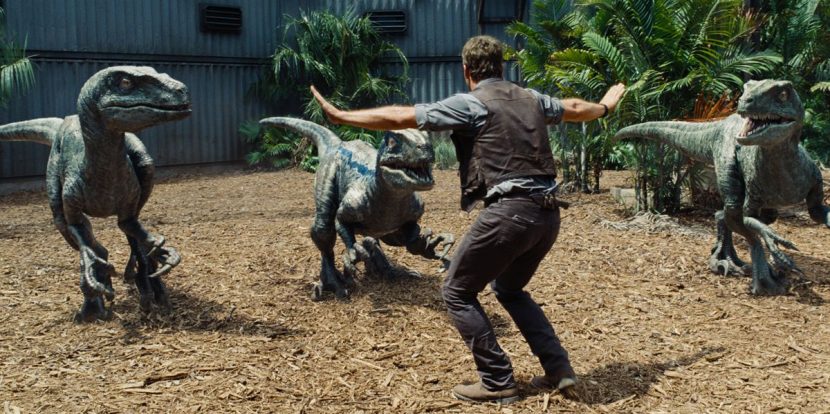
Since 1992 there have, of course, been numerous innovations made in bringing CG creatures to life, from more realistic rendering to muscle simulations and compositing. One further innovation utilized on Jurassic World was employing motion capture for dinosaur movement, particularly for the Velociraptors.
“We actually found we could translate a human performance onto the raptors fairly well,” notes Alexander. “It all came down to the re-targeting. We cast a few people here at ILM to be specific raptors. We knew how they needed to stand, how far they would bend over. We had a backpack they would put on that has a tail rig on it that had a bunch of points we could capture from that tail. It gave us really natural motion.”
Before launching into mocap, ILM conducted some crucial comparison tests. “We did some keyframe tests and mocap tests and the mocap tests actually had – it’s a little dirtier than keyframe but we wanted to have them a little ticky and less smooth – almost bird-like – and that was coming through on the motion capture performance. Colin was really liking it. So pretty early on in the process we tied ourselves into the motion capture performances. For very specific motion we would go and keyframe that, but for a raptor standing around and moving we actually got some very natural motions just off that rig.”
Championing the mocap effort was McIntosh, with motion capture supervisor Kevin Wooley. “A lot of [the reason for motion capture],” says McIntosh, “came from the sheer number of shots that we would have to get through, but it was also, ‘What can we do to take the performance and fidelity of detail to the next level?’ We would do motion study tests. We got them in front of Colin and he was really excited about them.”
McIntosh suggests, also, that mocap ‘fundamentally’ changed the approach to the dinosaur animation. “What it helped was to create an individuality to the raptors that are driven by a performer,” he says. “Then the character animator would go in and ‘plus’ it out and give it real life. But we could always refer back to the visual anchor of what the motion capture gave us.”
Solving the challenge of re-targeting human performance onto a raptor was one of the first challenges for the animators. “In some tests,” recalls McIntosh, “they could pick up my leg shaking because I was having to try and hold this sustained pose, which meant being tilted over, because a raptor is like a teeter totter which is over its hips. To try and get that meant trying to be parallel to the ground. Well, you could only do it for a very short period of time, but then the motion capture team at ILM developed technology where they could take a pose that was relatively sustainable and then globally pitch the performance over, so that we could get the performers into the classic raptor pose.”
Owen rescues a work from the raptor enclosure.
“That opened up things considerably,” adds McIntosh. “Even Dennis Muren described it as the musical equivalent of jazz. It was the opportunity to do numbers of different takes and performances and try different studies. We would look at the YouTube reference of the different animals and try and replicate that. Then that of course informs Colin’s cut. It means we’re very quickly able to get the entire sequence together and Colin could make suggestions. It was a fantastic opportunity to take advantage of what motion capture gives us. What we didn’t expect was that you could not only do it with the raptors but also the larger dinosaurs, and then scale that motion and get that in front of Colin for rough blocking.”
Muren himself was pleased with how much of the motion capture was useful. “What is the advantage of motion capture?,” Muren had posited. “Is there even one? Well there is. It’s the complexity of the motion. You can get far more stuff going on than can ever be animated by a great animator and you can do it for many shots for many characters – it will give it a look you haven’t seen before. I think it’s set a new bar and a higher standard.”
The final raptors were a collaboration between ILM and Image Engine, the latter studio incorporating an original ILM model into its pipeline. “ILM provided a near-final model of the raptor since there were also creating raptor scenes when the creatures appeared in scenes with other dinosaurs like the Indominus Rex, “outlines Image Engine visual effects supervisor Martyn Culpitt. “They gave us textures and models, and we made shaders and made sure our lookdev matched theirs. On this and on Turtles we switched over to full raytracing in 3Delight for rendering. It’s a very close tool to RenderMan which means we can work very closely to ILM, as all our AOVs and the way the stuff is broken out is very similar.”
Image Engine was able to use the mocap, too, in helping to drive animation beats. “It saved a lot of time in terms of the initial blocking out,” says Image Engine animation supervisor Jeremy Mesana. “We’d go and animate on top of that with the locomotion required for the shot. In terms of re-targeting, we came up with a good system to what we imagined as being the raptor poses, in certain scenarios. It was more about hunching them over and bending their feet, and adding more of animal nuances into the character. At the end of the day it’s still just a bi-ped.”
Image Engine would also deliver shots of the raptors engaged to hunt down the Indominus Rex (see below), the raptors chasing Claire (Bryce Dallas Howard) and the kids in a van, the lab sequence when Hoskins (Vincent D’Onofrio) is attacked, as well as an earlier extreme close-up shots of the raptor muzzles while they’re held in containment. “The emotion in the raptors for that scenes was really being sold with the eye itself,” says Mesana. “We couldn’t use the brows on the raptors – they were a rigid bone. All we were able to do was squint the eye and add very subtle pupil motion. That sold a lot of the life of the character.”
On the hunt
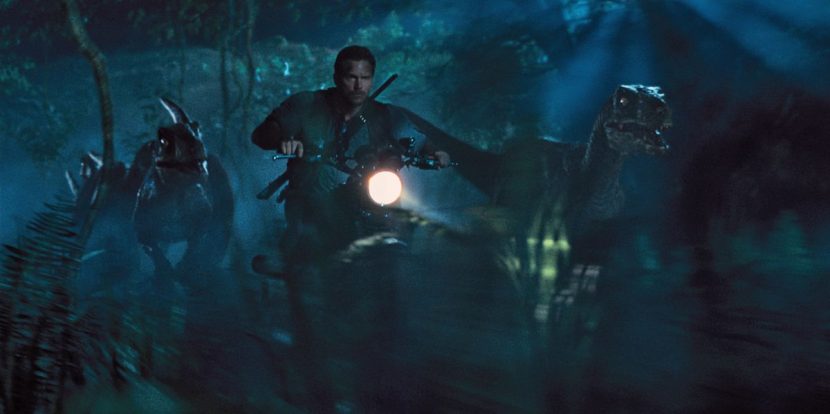
One of the film’s most exhilarating sequences features Owen’s ‘trained’ raptors heading out on the hunt for Indominus rex. Here, Owen and a crew weave through the jungle on motorbikes and other vehicles as the raptors race with them at high velocity. Practical photography and virtual cinematography techniques brought the sequence to life, again via an ILM and Image Engine collaboration.
“The raptor hunting scenes (in terms of their look and feel) evolved from the motion study tests that we did in pre-production,” explains McIntosh. “In the original Jurassic Park, Muldoon tells Dr. Grant that the raptors are capable of cheetah speed and Colin wanted to deliver on Muldoon’s promise and show that to the audience. We had seen how smart and cunning the raptors could be as hunters but we hadn’t seen them as these unbelievably agile and ferociously fast animals in their native jungle environment.”
The visual effects crew had the benefit of reviewing the actual 22-year old original full-sized raptor model crafted by Legacy Effects (formerly Stan Winston Studios). “What was so striking was just how large these animals were,” says McIntosh. “The statue had to be brought in through the lobby because it wouldn’t fit in the service elevator. It really helped the animation since you realized that these animals were around 6 feet tall but around 12-14 feet long and probably weighing around 500 pounds, as much as a full grown Bengal Tiger.”
That knowledge informed the animators’ approach to locomotion – mostly referencing an ostrich and tiger. “The ostrich,” notes McIntosh, “because it is not only the largest existing bird but it is the fastest two-legged animal on the planet. So the length of the steps and the cadence of the steps informed the animators. The tiger gave us the intense focus that predators have as they run where the body moves around the head but the head stays fixed and focused on its prey. The tiger also gave us the power of a predator that size charging and weaving through the jungle while on the hunt.
“The tiger also informed the silhouette of the raptors,” adds McIntosh. “Instead of their heads being held high like the graceful neck on the ostrich which actually goes back as it runs forward, we extended the raptors’ heads forward so they were leaning into the run but also straighter with their tails parallel to the ground to make them feel faster and more streamlined like the tiger.”
Some initial animation tests were carried out for the sequence, and edited together three or four months before shooting. “Al Nelson from Skywalker Sound even provided the sound for us,” says McIntosh. “Based on the script, we knew that the raptors would be wearing cameras and so what would we see if we were looking through those cameras? So we wanted to put the audience right in the middle of that chase with the cameras racing along beside, behind and in front of the raptors. The goal with the cameras was to imply there was a camera mounted on a motorcycle chasing the pack. So not having the raptors perfectly framed the entire time was okay because it gave the scenes a more visceral quality of trying to film real animals racing at 50mph! Colin loved the resulting shots so much that the test shots fell into the previs and then the actual plate photography that the second unit used as a template for the sequence.”
Both plate photography filmed on the north shore of Oahu at Kualoa Ranch and real jungle made up the final shots. Notes McIntosh: “We are constantly intercutting between the two. We are also adding vines and trees and thick jungle foliage to the existing plates because the motorcycle was actually traveling on a dirt road and not the jungle we needed. This also allowed the raptors to not just run in a straight line but jump, duck and weave and negotiate through the terrain. This made the shots much more dynamic because they could get closer to camera and also race away so the camera was never always the same distance to Owen or the raptors. Vines and plants could whip past camera in the foreground and background which served to not only immerse the raptor pack into their environment but interact with it and also emphasize the speed by seeing how fast they pass stationary objects like boulders, fallen trees and bushes. Throughout post production, we would add more vines and foliage to the shots to give Colin the energy he wanted for the sequence.”
Image Engine took some initial CG foliage created by ILM for a trailer shot and then delved into its own build via SpeedTree and other modeling. “We had a good place to work from since there was photography from Hawaii,” says Image Engine’s Culpitt. “We had close to 20,000 trees in some scenes with varying jungle and foliage. Most of it needed to be rigged so we could interact with the raptors running past, kicking up leaves and dust. We figured that you’d never be able to sim 8,000 leaves or plants, so we had to figure out ways to make it work. We’d have more canned versions of the trees or plants being hit to the left or right that we could then populate.”
What’s new in sims
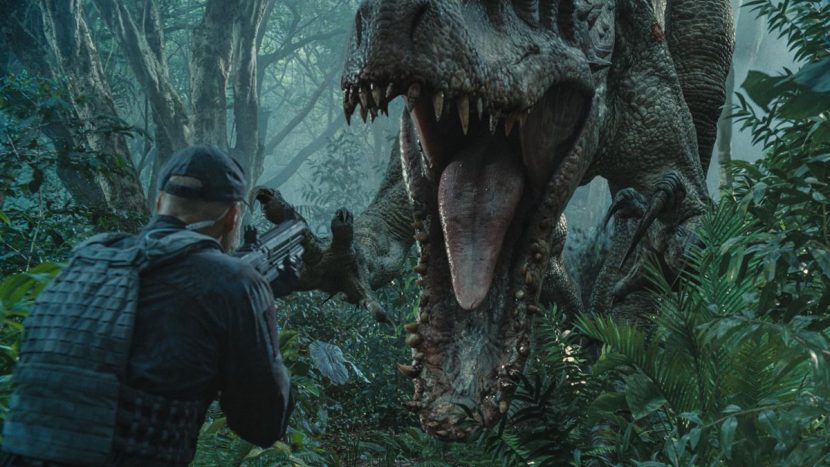
Helping also to sell the believability of its dinosaurs in Jurassic World was a new set of tools for simulating skin and muscle tissue based on real layers of bone, skin and muscles. “The dinosaurs have full bone structures, full muscle structures, flesh layer and another skin layer,” says Alexander. “How all that slides against the body and bones is one of the things we’ve take to another level. We really get the see the muscles firing. We have new tools for looking where the bones are and what muscles would be firing at that moment. It gives some really nice muscle motion when they’re running or even just walking around.”
“Typically animation would inform the simulation,” adds McIntosh, “and it would also in many ways kickstart the simulation. If we did nothing we would get some interesting aspects of impact tremors in the flesh or muscle. There’s also a tensing that precedes the movement – it’s new for Jurassic World in that it wasn’t just a secondary action as a result of the step, they’re using their muscles to take that step.”
Owen and an unfortunate worker try to escape the Indominus rex.
“We also had a tail rig where we could build muscle detail on top of that,” states McIntosh. “In typical texturing, if there’s stretching of the limbs the texture itself stretches, but they devise a system based on the scale detail where the space between the scales stretch, but not the scales themselves. You see that when you see a snake swallowing an egg and the skin between stretches but not the scales.”
More than just a tennis ball on a stick (but that as well)
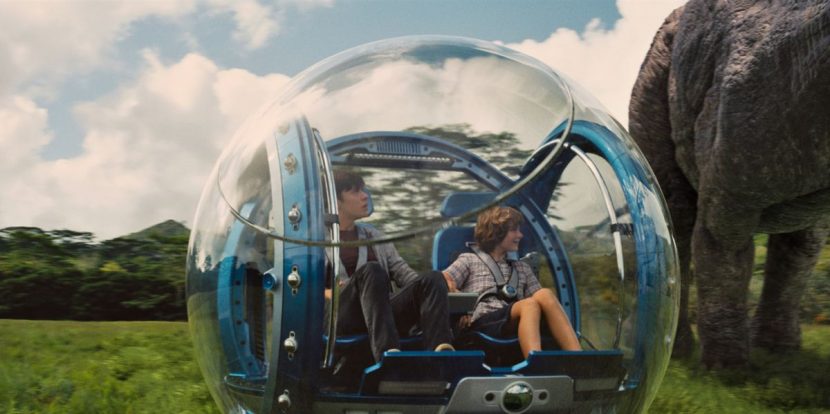
In the previous Jurassic films – as with many creature features – actors are required to perform without their reptilian co-stars on set. So they have to imagine them, a process often aided with a stick and a tennis ball, or a cardboard cut-out. On Jurassic World, these aides were still used – to great effect – but a more modern approach was also employed for both shooting and scouting dinosaur scenes.
“We had an on-set app to help view our dinosaurs with,” says Alexander. I took it on scouting and had it on set. On the scout we were in the forest figuring out where our dinosaurs had to go. I could load it up, it has camera lenses and camera backs and you can set what you’re shooting on, the aspect ratio and then you can put the model of your dinosaur in in realtime with basic lighting. Then when we were shooting shots, I would put the dinosaur in and show everybody.”
On set, the cast and crew also took advantage of a number of built set pieces and animatronics. Legacy Effects built a seven foot section of an Apatosaurus neck for a scene in which the animal dies in Owen’s lap. A full scale T-rex foot was fabricated to aid in framing up shots and for lighting reference. “We also had fifth scale maquettes of our Indominus rex to use for lighting reference,” says Alexander. “And we had a full scale Dimorphodon head, which is one of the flying birds. We used that while Owen was on the ground grappling with it.”
The kids check out some of the park's dinosaurs.
Since Owen also interacts closely with the raptors, production cast four dancers to shoot with. They wore gray suits and a ‘half-helmet’ raptor head to aid with eyelines and would then be filmed in the scenes and painted out afterwards with the benefit of clean plates. “Human beings and raptors are very different anatomically,” notes McIntosh, “but it let us figure out the show design and what the shots would be. The performers we did have were very athletic – some came from parkour backgrounds, and could sustain poses for extended periods. It also meant going to raptor school to make sure they were in the right poses, to make sure they were moving at a relative speed that made sense. All of that was going to be adjusted after the fact, but it helped composition and helped the actors knowing where it would be in the frame.”
A further level of interaction was required for all the foliage the dinosaurs would be running and breaking through. “That’s one of the things that differentiates this film from the originals,” says Alexander. “They are really hitting everything and touching everything and breaking things down. In the forest we would chop away at a lot of the foliage, because we knew we would either have to be roto’ing it or replacing it in the end anyway.
“We didn’t want to be stuck to the idea of there only being one branch move and someone would have a string that would move one aspect of the foliage,” adds McIntosh. “When the dinos move through their environment and so we made the foliage move in a correct way. So it actually meant clearing out the foliage in a given area so that we could put the dinosaurs in, knowing that we could then go back in and reproduce the foliage digitally so it will move correctly based on the performance of the dinosaurs.”
New heroes and villains
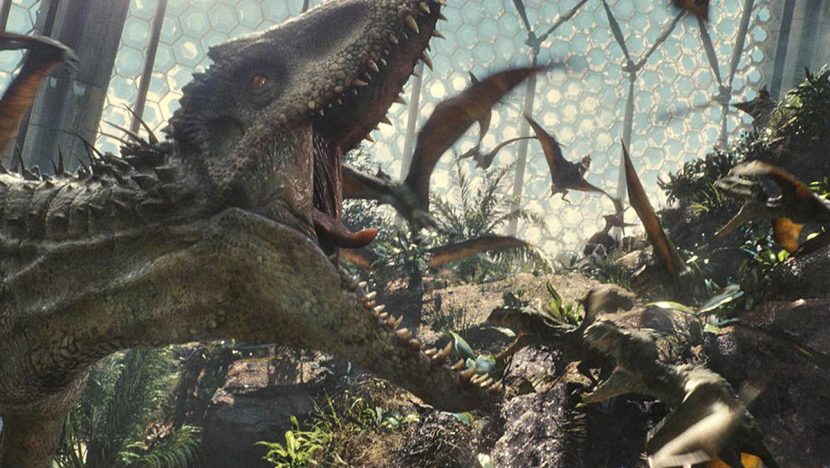
As noted, Jurassic World features several dinosaurs seen in the previous films, but this film also saw the advent of a new hybrid dinosaur – the Indominus rex. The dinosaur is made up of the DNA of other dinos, which gave ILM scope to imbue it with rather different, and striking, features. “Initial motion studies were done,” says McIntosh, “and we also quickly realized she would have long arms and raptor claws, and small thumbs. It opens up the world creatively to make her very distinct from a T-rex. Not only can she get down on all fours and sneak around this environment, she can push off with her claws to get up, use her claws to throw things around.”
“We did a bunch of animation tests to explore that,” adds McIntosh. “We found that if you overanimated or made it too anthropomorphic and human-like in its movement, it feels it. The goal was to always make sure she felt like a gigantic animal that was a theropod but taking advantage of its extra features.”
For the more traditional dinosaurs, ILM continued its long tradition of accumulating reference footage to give the creatures some basis in reality. “One of the mandates from day one was always the idea of creating visual anchors,” says McIntosh. “No one’s ever seen a living dinosaur but they’ve seen a lot of the living animals that are alive today. When the animators came onto the show, before they started a scene they would do a motion study. We would assign different motion studies to the different animators based on the different dinosaurs we knew we’d need for the different sequences. We would try and find an animal that matched the rough anatomy of what the dinosaurs were.”
“For example,” notes McIntosh, “the Apatosaurus – there are no existing animals that have such large necks, but in terms of the size and steps they’re taking, elephants are an excellent example of that. Also the way their skin jiggles and sags. You also have impact tremors that rise up through their legs as they take steps. For more stocky and robust dinosaurs, like Triceratops, we looked at rhinos and hippos that are four legged and built very low to the ground. The rhinos even have head ornamentation. We spent a lot of time researching National Geographic and studying the mannerisms of what the rhinos would do and slavishly copy them.”
The kids run from the Indominus rex.
For the animators, matching a real animal’s movements frame for frame on a dinosaur provided an important first step in creating a ‘real living breathing’ dinosaur. “It informed the animation in the sense of, ‘How quickly could you get away with something moving that fast?’” says McIntosh. “There was a YouTube video of an elephant coming out of the jungle and confronting a tourist holding a camera. What was surprising was that an elephant weighing five tonnes could very quickly cover a very short distance, which you normally wouldn’t imagine. So we thought if an elephant can do that we would certainly get away with it on a dinosaur – even though the actual anatomy is slightly different. What was invaluable was having Jack Horner on set – one of the most noted paleo’s in the world. It was an opportunity to pick his brain about that very question.”
Jurassic World at SIGGRAPH
ILM has a big showing at SIGGRAPH this year in LA, including with Jurassic World presentations. There’s a main production session, then other sessions that delve deeply into motion capture and geometric transfer solutions for the dinosaurs.
Herons also proved to be useful reference for how the raptors and other dinosaurs would hunt. “There’s a stillness to it when it’s looking at its prey,” explains McIntosh. “Then it would get very, very low and do very quick movements – there’s an economy of movement and very little anticipation which is not what we typically do in animation. It made the performance feel more real. If the audience is looking at it on the big screen, they’ve seen a crow or the way a lion stalks a gazelle and they are like, ‘Oh, that reminds me of a lion, because it reminds them of something they’ve seen before, it feels real to them, even though it’s not real.”
All images and clips copyright © 2015 Universal Pictures.
